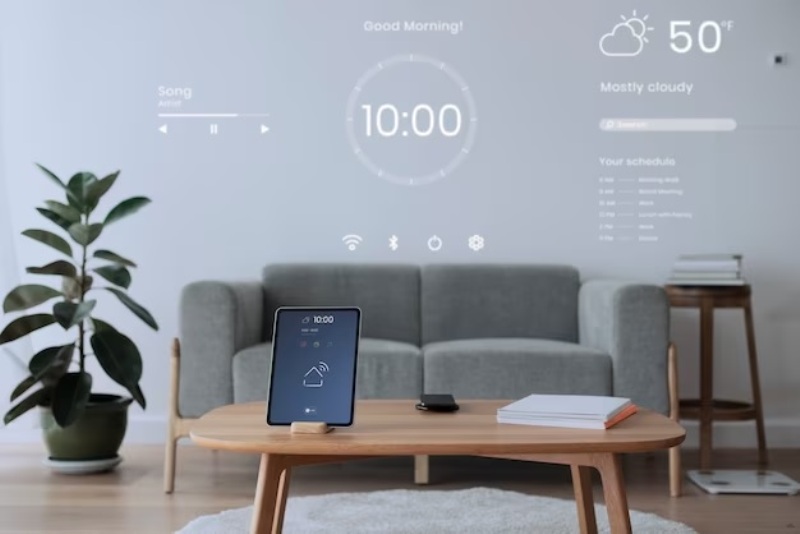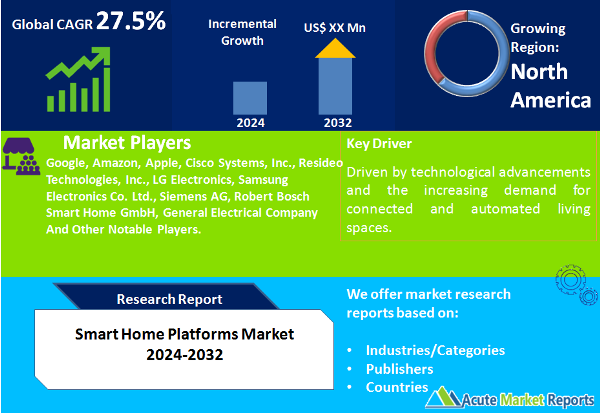
The smart home platforms market is a dynamic and rapidly evolving sector, driven by technological advancements and the increasing demand for connected and automated living spaces. The smart home platforms market is expected to grow at a CAGR of 27.5% during the forecast period of 2025 to 2033. The industry's commitment to enhancing security, lighting control, kitchen automation, and overall user experiences underscores its significance in providing advanced and interconnected solutions for modern homes. As the market evolves, addressing challenges in protocol standardization, navigating diverse technological landscapes, and adapting to the specific needs of different regions will be crucial for sustained growth in the smart home platforms market.
Integration of Security & Access Controls: Enhanced Home Security and Access Management
The integration of Security and Access Controls stands out as a pivotal driver in the smart home platforms market. Evidence points towards a surge in demand for platforms that seamlessly incorporate robust security measures and efficient access controls. In 2024, the market witnessed a notable increase in the adoption of smart home platforms offering integrated security solutions, including smart locks, surveillance cameras, and access management systems. These platforms not only enhance home security but also provide homeowners with convenient and flexible access control. The highest Compound Annual Growth Rate (CAGR) from 2025 to 2033 is expected in this segment, highlighting the growing importance of security features in smart home ecosystems. This driver underscores the industry's response to the increasing need for comprehensive security solutions in residential spaces.
Innovations in Lighting Control: Transforming Ambiance and Energy Efficiency
The smart home platforms market experiences significant growth through innovations in Lighting Control. Evidence indicates a shift towards smart lighting solutions that offer advanced control over ambiance and energy efficiency. In 2024, the market saw a surge in the adoption of platforms enabling users to personalize lighting settings, adjust brightness, and optimize energy consumption. These innovations not only contribute to a more comfortable living environment but also align with the growing focus on sustainable and energy-efficient homes. The highest CAGR during the forecast period from 2025 to 2033 is expected in Lighting Control, showcasing its central role in shaping the future of smart home platforms. This driver highlights the industry's commitment to enhancing user experiences and promoting energy conservation through intelligent lighting solutions.

Rise in Smart Kitchen Appliances Adoption: Elevating Kitchen Automation and Convenience
The smart home platforms market is driven by the rising adoption of smart kitchen appliances. Evidence highlights a growing trend where homeowners seek platforms that seamlessly integrate and control various kitchen devices. In 2024, the market observed increased demand for platforms facilitating the management of smart refrigerators, ovens, coffee makers, and other kitchen appliances. These platforms not only enhance kitchen automation but also contribute to overall convenience and efficiency in daily tasks. The highest CAGR during the forecast period from 2025 to 2033 is expected in Smart Kitchen Appliances, reflecting the evolving lifestyle preferences and the desire for interconnected and intelligent kitchens. This driver emphasizes the industry's focus on providing comprehensive solutions that extend beyond traditional home automation.
Challenges in Standardizing Protocols: Navigating Interoperability Hurdles
A significant restraint in the smart home platforms market is associated with challenges in standardizing protocols. Evidence includes hurdles related to ensuring interoperability among devices using different wireless, wired, or hybrid protocols. In 2024, these challenges posed obstacles to both manufacturers and consumers, particularly in creating seamless ecosystems where devices from different brands can seamlessly communicate and work together. This restraint underscores the industry's need to address standardization issues to achieve a more interconnected and user-friendly smart home experience. As the market evolves, stakeholders must prioritize efforts to establish common protocols and standards, fostering greater compatibility and ease of integration for smart home devices.
By Products: Security & Access Controls Dominate the Market
In 2024, the smart home platforms market showcased substantial revenue from Security and Access Controls, indicating a heightened focus on home security. Lighting Control also contributed significantly, reflecting the increasing popularity of customizable lighting solutions. Smart Kitchen Appliances emerged as a major contributor to market revenue, aligning with the trend of kitchen automation. The highest CAGR during the forecast period from 2025 to 2033 is expected in Security and Access Controls, underlining the continued importance of robust security features in smart home platforms. This segmentation highlights the diverse range of products driving growth in the market and catering to various aspects of modern living.
By Protocols: Wireless Protocols Dominate the Market
The market exhibited notable revenue from Wireless Protocols in 2024, reflecting the widespread adoption of wireless connectivity in smart home devices. Wired Protocols also played a crucial role, particularly in applications where stable and high-bandwidth connections are essential. Hybrid protocols demonstrated their significance, offering a balanced approach that combines the strengths of both wireless and wired solutions. The highest CAGR during the forecast period from 2025 to 2033 is expected in Wireless Protocols, emphasizing the continued dominance of wireless connectivity in smart home platforms. This segmentation underscores the diverse technological landscape of smart home platforms and the specific protocols shaping market dynamics.
North America Remains the Global Leader
Geographically, the smart home platforms market demonstrated dynamic trends in 2024, with North America leading in both revenue generation and the highest CAGR. This reflects the region's strong consumer demand for advanced smart home solutions and the presence of key industry players. Europe also contributed substantially to revenue, with a slightly lower CAGR indicative of mature but steady growth. The Asia-Pacific region exhibited notable growth, highlighting the increasing adoption of smart home platforms in emerging economies. This geographic segmentation underscores the global nature of the smart home platforms market, with different regions playing distinct roles in shaping its trajectory.
Market Competition to Intensify during the Forecast Period
In the competitive landscape, top players such as Google, Amazon, Apple, Cisco Systems, Inc., Resideo Technologies, Inc., LG Electronics, Samsung Electronics Co. Ltd., Siemens AG, Robert Bosch Smart Home GmbH, and General Electrical Company play pivotal roles in steering the smart home platforms market. These industry giants, with their widely adopted platforms like Google Home, Amazon Alexa, and Apple HomeKit, significantly influence market dynamics. In 2024, these companies reported substantial revenues, setting the tone for competitive trends. The overall outlook of the market is characterized by continuous innovation, strategic partnerships, and a focus on providing seamless and integrated smart home experiences. As the market progresses from 2025 to 2033, the competitive landscape is expected to witness further dynamism, with key players continuing to shape the future of smart home platforms through technological advancements and user-centric solutions.
Historical & Forecast Period
This study report represents analysis of each segment from 2023 to 2033 considering 2024 as the base year. Compounded Annual Growth Rate (CAGR) for each of the respective segments estimated for the forecast period of 2025 to 2033.
The current report comprises of quantitative market estimations for each micro market for every geographical region and qualitative market analysis such as micro and macro environment analysis, market trends, competitive intelligence, segment analysis, porters five force model, top winning strategies, top investment markets, emerging trends and technological analysis, case studies, strategic conclusions and recommendations and other key market insights.
Research Methodology
The complete research study was conducted in three phases, namely: secondary research, primary research, and expert panel review. key data point that enables the estimation of Smart Home Platforms market are as follows:
Market forecast was performed through proprietary software that analyzes various qualitative and quantitative factors. Growth rate and CAGR were estimated through intensive secondary and primary research. Data triangulation across various data points provides accuracy across various analyzed market segments in the report. Application of both top down and bottom-up approach for validation of market estimation assures logical, methodical and mathematical consistency of the quantitative data.
| ATTRIBUTE | DETAILS |
|---|---|
| Research Period | 2023-2033 |
| Base Year | 2024 |
| Forecast Period | 2025-2033 |
| Historical Year | 2023 |
| Unit | USD Million |
| Segmentation | |
Products
| |
Protocols
| |
Application
| |
|
Region Segment (2023-2033; US$ Million)
|
Key questions answered in this report